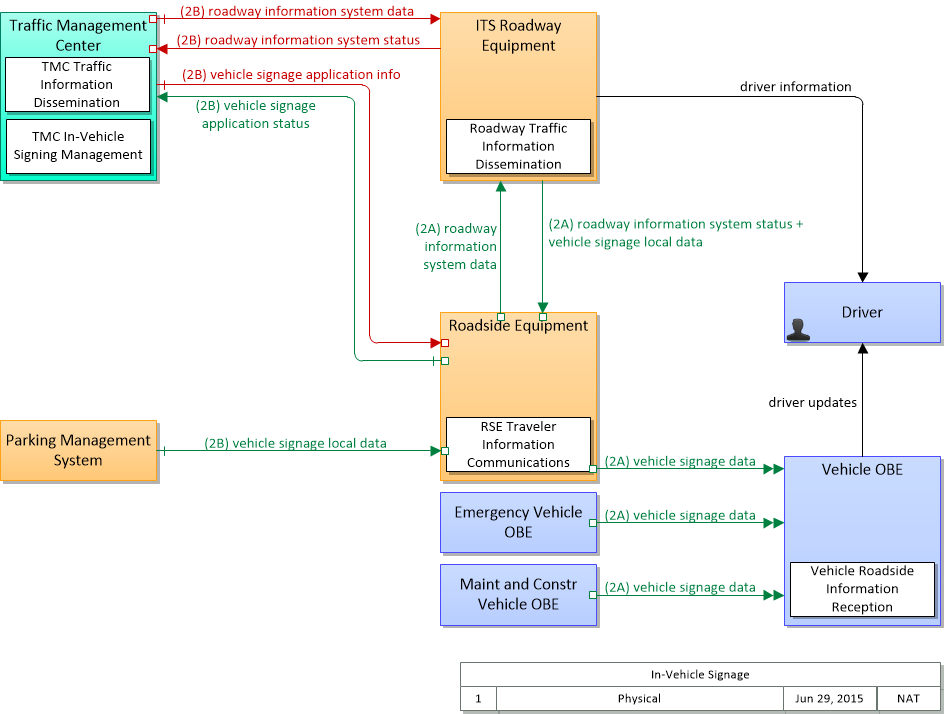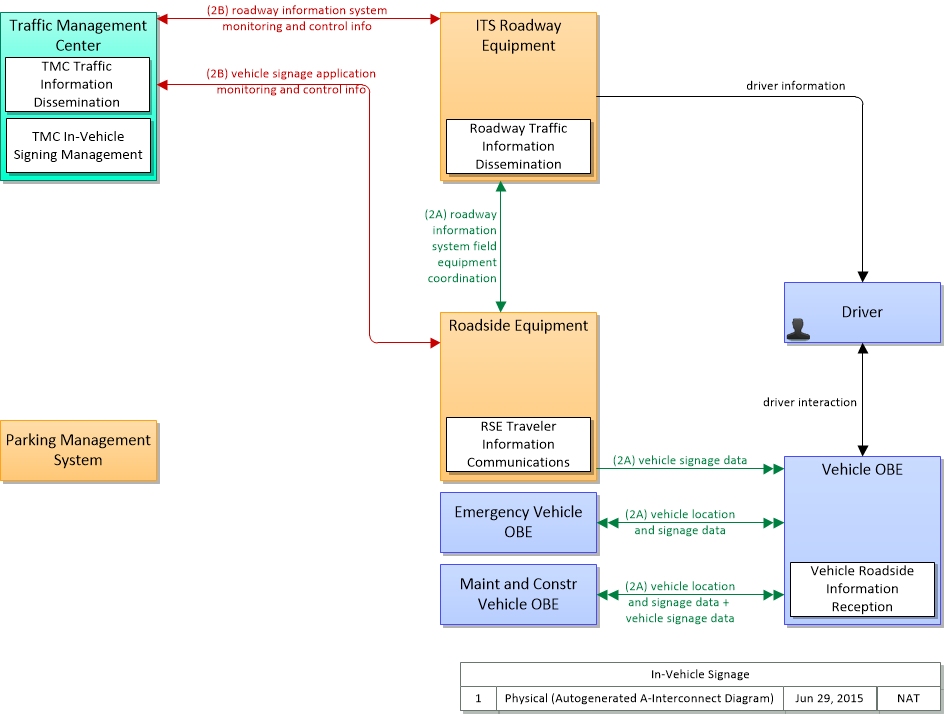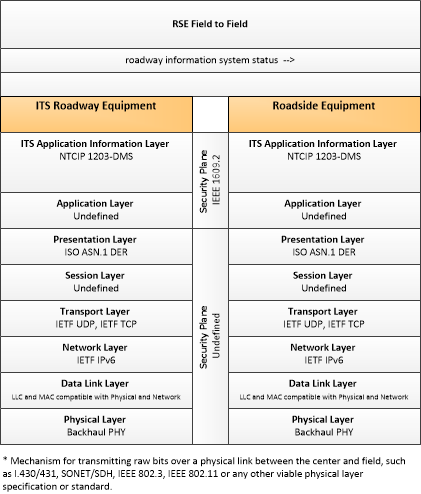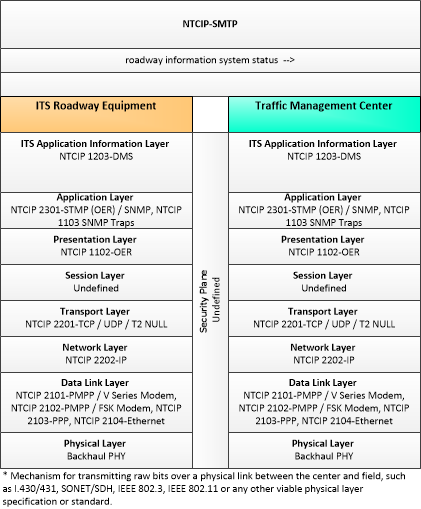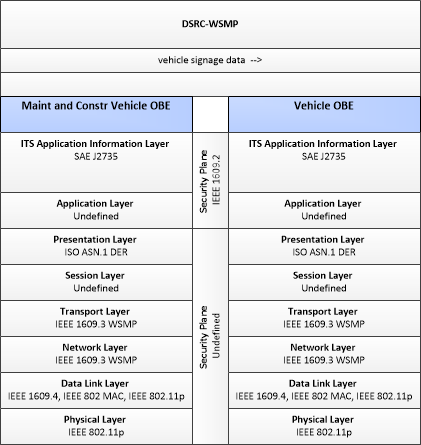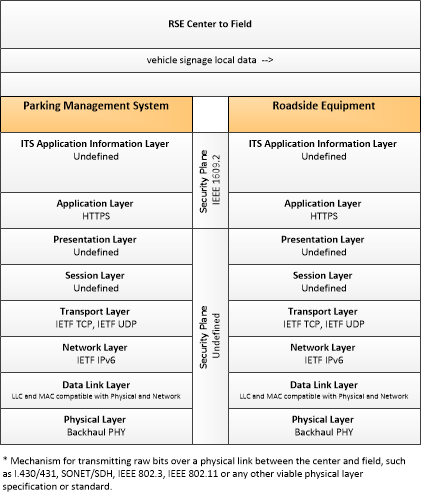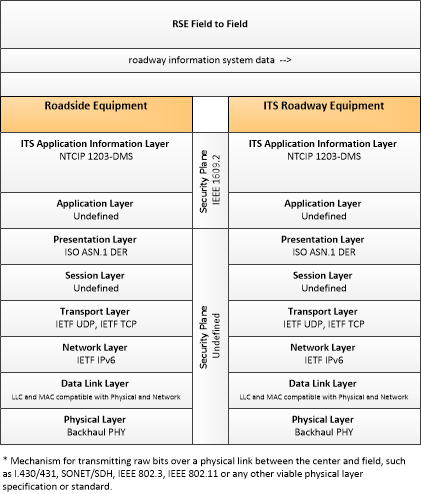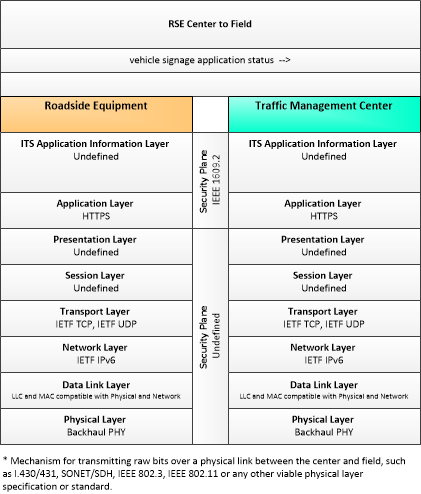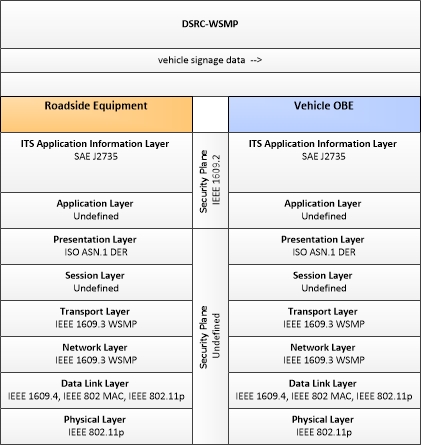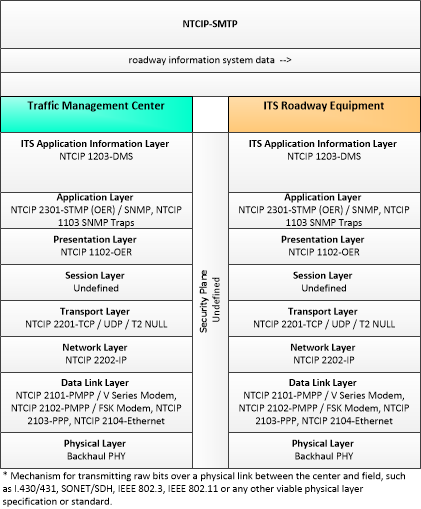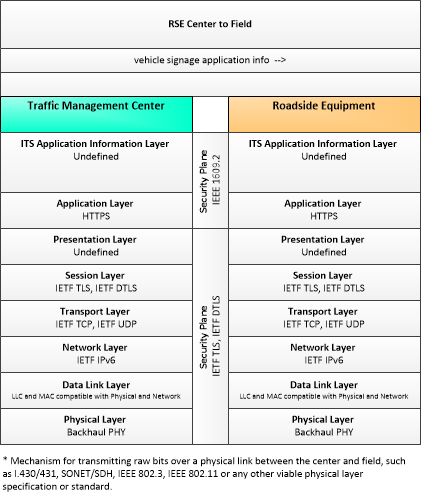Type: Safety
Groups:- V2I Safety
In-Vehicle Signage
The In-Vehicle Signage application augments regulatory, warning, and informational signs and signals by providing information directly to drivers through in-vehicle devices. The information provided would include static sign information (e.g., stop, curve warning, guide signs, service signs, and directional signs) and dynamic information (e.g., current signal states including highway intersection and highway-rail intersection status and local conditions warnings identified by local environmental sensors). This application also includes the capability for maintenance and construction and emergency vehicles to transmit sign information to vehicles in the vicinity so that in vehicle signing can be used without fixed infrastructure in work zones and around incidents.
Enterprise
SVG Diagram
PNG Diagram

Business Interaction Matrix:
| In-Vehicle Signage Operations Stage | ||||||||||||||
|---|---|---|---|---|---|---|---|---|---|---|---|---|---|---|
| Vehicle Owner | Driver | Vehicle OBE Owner | Roadway Owner | RSE Owner | RSE Operator | ITS Roadway Equipment Owner | ITS Roadway Operator | Traffic Manager | Maint and Constr Vehicle Owner | Emergency Vehicle Manager | RSE Traveler Information Communications Provider | Parking Manager | Vehicle Roadside Information Reception Provider | |
| Vehicle Owner | Vehicle Usage Agreement | Vehicle OBE Usage Agreement | Application Usage Agreement | |||||||||||
| Driver | Vehicle Usage Agreement | Expectation of Information Provision | Expectation of Information Provision | Expectation of Information Provision | Expectation of Information Provision | |||||||||
| Vehicle OBE Owner | Vehicle OBE Usage Agreement | Expectation of Information Provision | Expectation of Information Provision | |||||||||||
| Roadway Owner | Service Delivery Agreement | |||||||||||||
| RSE Owner | Expectation of Information Provision | Service Delivery Agreement | Operations Agreement | Information Exchange and Action Agreement | Information Exchange and Action Agreement | Application Usage Agreement | Information Provision Agreement | |||||||
| RSE Operator | Operations Agreement | |||||||||||||
| ITS Roadway Equipment Owner | Expectation of Information Provision | Information Exchange and Action Agreement | Operations Agreement | Information Exchange and Action Agreement | ||||||||||
| ITS Roadway Operator | Operations Agreement | |||||||||||||
| Traffic Manager | Information Exchange and Action Agreement | Information Exchange and Action Agreement | ||||||||||||
| Maint and Constr Vehicle Owner | Expectation of Information Provision | |||||||||||||
| Emergency Vehicle Manager | Expectation of Information Provision | |||||||||||||
| RSE Traveler Information Communications Provider | Application Usage Agreement | |||||||||||||
| Parking Manager | Information Provision Agreement | |||||||||||||
| Vehicle Roadside Information Reception Provider | Application Usage Agreement | |||||||||||||
Includes Enterprise Objects:
| Enterprise Object | Description |
|---|---|
| Driver | The 'Driver' represents the person that operates a vehicle on the roadway. Included are operators of private, transit, commercial, and emergency vehicles where the interactions are not particular to the type of vehicle (e.g., interactions supporting vehicle safety applications). The Driver originates driver requests and receives driver information that reflects the interactions which might be useful to all drivers, regardless of vehicle classification. Information and interactions which are unique to drivers of a specific vehicle type (e.g., fleet interactions with transit, commercial, or emergency vehicle drivers) are covered by separate objects. |
| Emergency Vehicle Manager | The enterprise that controls and manages emergency vehicle operations. |
| ITS Roadway Equipment Owner | The entity that owns the Roadway ITS equipment. |
| ITS Roadway Operator | The entity that operates the Roadway ITS equipment. |
| Maint and Constr Vehicle Owner | The individual, group of individuals or corporate entity that owns the maintenance and/or construction vehicle. |
| Parking Manager | The organization that manages parking facilities, including lots, access control, parking meters. |
| Roadway Owner | The owner of the roadway proximate to which roadside equipment will be/is installed. |
| RSE Operator | The entity that operates roadside equipment in the transportation environment. |
| RSE Owner | The owner of roadside equipment. |
| RSE Traveler Information Communications Provider | Application Component Providers are specified more by role than by function. Providers are responsible for the development of the application component, including initial creation, enhancement and bug fixes. Delivery of the application to the end user may require relationships with other entities (installers, maintainers) if the provider chooses not to fulfill those roles. |
| Traffic Manager | The entity responsible for the management of traffic, both freeway and arterial. |
| Vehicle OBE Owner | The entity, individual, group or corporation that owns the Vehicle On-Board equipment. This could be the same as the Vehicle Owner, but it could be a third part that licenses the use of the OBE to the Owner. |
| Vehicle Owner | The individual, group of individuals or corporate entity that is identified as the registered owner of the Vehicle under state law. |
| Vehicle Roadside Information Reception Provider | Application Component Providers are specified more by role than by function. Providers are responsible for the development of the application component, including initial creation, enhancement and bug fixes. Delivery of the application to the end user may require relationships with other entities (installers, maintainers) if the provider chooses not to fulfill those roles. |
Includes Resources:
| Resource | Description |
|---|---|
| Emergency Vehicle | The "Emergency Vehicle" represents a range of vehicles including those operated by police, fire, and emergency medical services, as well as incident response vehicles including towing and recovery vehicles and freeway service patrols. |
| Emergency Vehicle OBE | The Emergency Vehicle On-Board Equipment (OBE) resides in an emergency vehicle and provides the processing, storage, and communications functions that support public safety-related connected vehicle applications. It represents a range of vehicles including those operated by police, fire, and emergency medical services. In addition, it represents other incident response vehicles including towing and recovery vehicles and freeway service patrols. It includes two-way communications to support coordinated response to emergencies. In CVRIA, a separate 'Vehicle OBE' physical object supports the general V2V and V2I safety applications and other applications that apply to all vehicles, including emergency vehicles. The Emergency Vehicle OBE supplements these general capabilities with capabilities that are specific to emergency vehicles. |
| ITS Roadway Payment Equipment | 'ITS Roadway Payment Equipment' represents the roadway components of a toll collection system. It provides the capability for vehicle operators to pay tolls without stopping their vehicles. It supports use of locally determined pricing structures and includes the capability to implement various variable pricing policies. Typically, transactions are accompanied by feedback to the customer and a record of the transactions is provided to a back office system (e.g., the Payment Administration Center). |
| Maint and Constr Vehicle | This physical object resides in a maintenance, construction, or other specialized service vehicle or equipment and provides the sensory, processing, storage, and communications functions necessary to support highway maintenance and construction. All types of maintenance and construction vehicles are covered, including heavy equipment and supervisory vehicles. The subsystem provides two-way communications between drivers/operators and dispatchers and maintains and communicates current location and status information. A wide range of operational status is monitored, measured, and made available, depending on the specific type of vehicle or equipment. For example, for a snow plow, the information would include whether the plow is up or down and material usage information. The subsystem may also contain capabilities to monitor vehicle systems to support maintenance of the vehicle itself and other sensors that monitor environmental conditions including the road condition and surface weather information. This subsystem can represent a diverse set of mobile environmental sensing platforms, including wheeled vehicles and any other vehicle that collects and reports environmental information. |
| Maint and Constr Vehicle OBE | The 'Maint and Constr Vehicle OBE' resides in a maintenance, construction, or other specialized service vehicle or equipment and provides the processing, storage, and communications functions necessary to support highway maintenance and construction. All types of maintenance and construction vehicles are covered, including heavy equipment and supervisory vehicles. The MCV OBE provides two-way communications between drivers/operators and dispatchers and maintains and communicates current location and status information. A wide range of operational status is monitored, measured, and made available, depending on the specific type of vehicle or equipment. A snow plow for example, would monitor whether the plow is up or down and material usage information. The Maint and Constr Vehicle OBE may also contain capabilities to monitor vehicle systems to support maintenance of the vehicle itself and include sensors that monitor environmental conditions such as road condition and surface weather information. This can include a diverse set of mobile environmental sensing platforms, including wheeled vehicles and any other vehicle that collects and reports environmental information. In CVRIA, a separate 'Vehicle OBE' physical object supports the general V2V and V2I safety applications and other applications that apply to all vehicles, including maintenance and construction vehicles. The Maint and Constr Vehicle OBE supplements these general applications with applications that are specific to maintenance and construction vehicles. |
| Parking Management System | The Parking Management System provides electronic monitoring and management of parking facilities. It supports an I2V link to the Vehicle that allows electronic collection of parking fees and monitors and controls parking meters that support conventional parking fee collection. It also includes the instrumentation, signs, and other infrastructure that monitors parking lot usage and provides local information about parking availability and other general parking information. This portion of the functionality must be located in the parking facility where it can monitor, classify, and share information with customers and their vehicles. It also interfaces with the financial infrastructure and broadly disseminates parking information to other operational centers in the region. Note that the latter functionality may be located in a back office, remote from the parking facility. |
| Roadside Equipment | 'Roadside Equipment' (RSE) represents the Connected Vehicle roadside devices that are used to send messages to, and receive messages from, nearby vehicles using Dedicated Short Range Communications (DSRC) or other alternative wireless communications technologies. Communications with adjacent field equipment and back office centers that monitor and control the RSE are also supported. This device operates from a fixed position and may be permanently deployed or a portable device that is located temporarily in the vicinity of a traffic incident, road construction, or a special event. It includes a processor, data storage, and communications capabilities that support secure communications with passing vehicles, other field equipment, and centers. |
| Roadway Traffic Information Dissemination | "Roadway Traffic Information Dissemination" includes field elements that provide information to drivers, including dynamic message signs and highway advisory radios. |
| RSE Traveler Information Communications | "RSE Traveler Information Communications" includes field elements that distribute information to vehicles for in-vehicle display. The information may be provided by a center (e.g., variable information on traffic and road conditions in the vicinity of the field equipment) or it may be determined and output locally (e.g., static sign information and signal phase and timing information). This includes the interface to the center or field equipment that controls the information distribution and the short range communications equipment that provides information to passing vehicles. |
| TMC In-Vehicle Signing Management | "TMC In-Vehicle Signing Management" controls and monitors RSEs that support in-vehicle signing. Sign information that may include static regulatory, service, and directional sign information as well as variable information such as traffic and road conditions can be provided to the RSE, which uses short range communications to send the information to in-vehicle equipment. Information that is currently being communicated to passing vehicles and the operational status of the field equipment is monitored by this application. The operational status of the field equipment is reported to operations personnel. |
| TMC Traffic Information Dissemination | "TMC Traffic Information Dissemination" disseminates traffic and road conditions, closure and detour information, incident information, driver advisories, and other traffic-related data to other centers, the media, and driver information systems. It monitors and controls driver information system field equipment including dynamic message signs and highway advisory radio, managing dissemination of driver information through these systems. |
| Traffic Management Center | The 'Traffic Management Center' monitors and controls traffic and the road network. It represents centers that manage a broad range of transportation facilities including freeway systems, rural and suburban highway systems, and urban and suburban traffic control systems. It communicates with ITS Roadway Equipment and Connected Vehicle Roadside Equipment (RSE) to monitor and manage traffic flow and monitor the condition of the roadway, surrounding environmental conditions, and field equipment status. It manages traffic and transportation resources to support allied agencies in responding to, and recovering from, incidents ranging from minor traffic incidents through major disasters. |
| Vehicle | The conveyance that provides the sensory, processing, storage, and communications functions necessary to support efficient, safe, and convenient travel. These functions reside in general vehicles including personal automobiles, commercial vehicles, emergency vehicles, transit vehicles, or other vehicle types. |
| Vehicle OBE | The Vehicle On-Board Equipment (OBE) provides the vehicle-based processing, storage, and communications functions necessary to support connected vehicle operations. The radio(s) supporting V2V and V2I communications are a key component of the Vehicle OBE. This communication platform is augmented with processing and data storage capability that supports the connected vehicle applications. In CVRIA, the Vehicle OBE includes the functions and interfaces that support connected vehicle applications for passenger cars, trucks, and motorcycles. Many of these applications (e.g., V2V Safety applications) apply to all vehicle types including personal vehicles, commercial vehicles, emergency vehicles, transit vehicles, and maintenance vehicles. From this perspective, the Vehicle OBE includes the common interfaces and functions that apply to all motorized vehicles. |
| Vehicle Roadside Information Reception | "Vehicle Roadside Information Reception" receives advisories, vehicle signage data, and other driver information and presents this information to the driver using in-vehicle equipment. Information presented may include fixed sign information, traffic control device status (e.g., signal phase and timing data), advisory and detour information, warnings of adverse road and weather conditions, travel times, and other driver information. |
Includes Roles:
| Role | Description |
|---|---|
| Operates | An Enterprise controls the functionality and state of the target Resource. An Enterprise that Operates a resource is considered Responsible. |
| Owns | An Enterprise has financial ownership and control over the Resource. An Enterprise that Owns a resource is considered Accountable. |
Includes Coordination:
| Coordination | Type | Description |
|---|---|---|
| Application Usage Agreement | Agreement | An agreement in which one entity that controls an application component's use gives the other entity the necessary tools and permission to operate that application or application component. |
| Expectation of Information Provision | Expectation | An expectation where one party believes another party will provide it information whenever such information is likely relevant to the recipient. |
| Includes | Includes | Indicates that one component is entirely contained within another component. |
| Information Exchange and Action Agreement | Agreement | An agreement to exchange information, which may include data or control information; the exact information to be exchanged may vary from agreement to agreement. This also includes a specification for action that shall, should or may be taken by one party in response to this information. |
| Information Provision Agreement | Agreement | An agreement where one party agrees to provide information to another party. This is a unidirectional agreement. |
| Operations Agreement | Agreement | An agreement where one entity agrees to operate a device or application on behalf of another, device/application controlling entity. |
| Service Delivery Agreement | Agreement | A relationship where one party agrees to provide a service to the other party. This agreement may specify the expected performance of this service in terms of availability and/or actions/time-type performance specifications. |
| Vehicle OBE Usage Agreement | Agreement | An agreement that grants one entity permission to use a Vehicle OBE that the other party controls. |
| Vehicle Usage Agreement | Agreement | An agreement between the owner of a vehicle and a prospective operator, whereupon the owner allows the operator to use the vehicle. |
Functional
Includes Processes:
| Level | Name | Type | Allocated to Application Object |
|---|
Includes Data Flows:
| Source Pspec | Data Flow | Destination Pspec |
|---|
Physical
SVG Diagram
PNG Diagram

Includes Physical Objects:
| Physical Object | Class | Description |
|---|---|---|
| Driver | Vehicle | The 'Driver' represents the person that operates a vehicle on the roadway. Included are operators of private, transit, commercial, and emergency vehicles where the interactions are not particular to the type of vehicle (e.g., interactions supporting vehicle safety applications). The Driver originates driver requests and receives driver information that reflects the interactions which might be useful to all drivers, regardless of vehicle classification. Information and interactions which are unique to drivers of a specific vehicle type (e.g., fleet interactions with transit, commercial, or emergency vehicle drivers) are covered by separate objects. |
| Emergency Vehicle OBE | Vehicle | The Emergency Vehicle On-Board Equipment (OBE) resides in an emergency vehicle and provides the processing, storage, and communications functions that support public safety-related connected vehicle applications. It represents a range of vehicles including those operated by police, fire, and emergency medical services. In addition, it represents other incident response vehicles including towing and recovery vehicles and freeway service patrols. It includes two-way communications to support coordinated response to emergencies. In CVRIA, a separate 'Vehicle OBE' physical object supports the general V2V and V2I safety applications and other applications that apply to all vehicles, including emergency vehicles. The Emergency Vehicle OBE supplements these general capabilities with capabilities that are specific to emergency vehicles. |
| ITS Roadway Equipment | Field | 'ITS Roadway Equipment' represents the ITS equipment that is distributed on and along the roadway that monitors and controls traffic and monitors and manages the roadway itself. In CVRIA, this physical object represents all of the other ITS field equipment that interfaces with and supports the Connected Vehicle Roadside Equipment (RSE). This physical object includes traffic detectors, environmental sensors, traffic signals, highway advisory radios, dynamic message signs, CCTV cameras and video image processing systems, grade crossing warning systems, and ramp metering systems. Lane management systems and barrier systems that control access to transportation infrastructure such as roadways, bridges and tunnels are also included. This object also provides environmental monitoring including sensors that measure road conditions, surface weather, and vehicle emissions. Work zone systems including work zone surveillance, traffic control, driver warning, and work crew safety systems are also included. |
| Maint and Constr Vehicle OBE | Vehicle | The 'Maint and Constr Vehicle OBE' resides in a maintenance, construction, or other specialized service vehicle or equipment and provides the processing, storage, and communications functions necessary to support highway maintenance and construction. All types of maintenance and construction vehicles are covered, including heavy equipment and supervisory vehicles. The MCV OBE provides two-way communications between drivers/operators and dispatchers and maintains and communicates current location and status information. A wide range of operational status is monitored, measured, and made available, depending on the specific type of vehicle or equipment. A snow plow for example, would monitor whether the plow is up or down and material usage information. The Maint and Constr Vehicle OBE may also contain capabilities to monitor vehicle systems to support maintenance of the vehicle itself and include sensors that monitor environmental conditions such as road condition and surface weather information. This can include a diverse set of mobile environmental sensing platforms, including wheeled vehicles and any other vehicle that collects and reports environmental information. In CVRIA, a separate 'Vehicle OBE' physical object supports the general V2V and V2I safety applications and other applications that apply to all vehicles, including maintenance and construction vehicles. The Maint and Constr Vehicle OBE supplements these general applications with applications that are specific to maintenance and construction vehicles. |
| Parking Management System | Field | The Parking Management System provides electronic monitoring and management of parking facilities. It supports an I2V link to the Vehicle that allows electronic collection of parking fees and monitors and controls parking meters that support conventional parking fee collection. It also includes the instrumentation, signs, and other infrastructure that monitors parking lot usage and provides local information about parking availability and other general parking information. This portion of the functionality must be located in the parking facility where it can monitor, classify, and share information with customers and their vehicles. It also interfaces with the financial infrastructure and broadly disseminates parking information to other operational centers in the region. Note that the latter functionality may be located in a back office, remote from the parking facility. |
| Roadside Equipment | Field | 'Roadside Equipment' (RSE) represents the Connected Vehicle roadside devices that are used to send messages to, and receive messages from, nearby vehicles using Dedicated Short Range Communications (DSRC) or other alternative wireless communications technologies. Communications with adjacent field equipment and back office centers that monitor and control the RSE are also supported. This device operates from a fixed position and may be permanently deployed or a portable device that is located temporarily in the vicinity of a traffic incident, road construction, or a special event. It includes a processor, data storage, and communications capabilities that support secure communications with passing vehicles, other field equipment, and centers. |
| Traffic Management Center | Center | The 'Traffic Management Center' monitors and controls traffic and the road network. It represents centers that manage a broad range of transportation facilities including freeway systems, rural and suburban highway systems, and urban and suburban traffic control systems. It communicates with ITS Roadway Equipment and Connected Vehicle Roadside Equipment (RSE) to monitor and manage traffic flow and monitor the condition of the roadway, surrounding environmental conditions, and field equipment status. It manages traffic and transportation resources to support allied agencies in responding to, and recovering from, incidents ranging from minor traffic incidents through major disasters. |
| Vehicle OBE | Vehicle | The Vehicle On-Board Equipment (OBE) provides the vehicle-based processing, storage, and communications functions necessary to support connected vehicle operations. The radio(s) supporting V2V and V2I communications are a key component of the Vehicle OBE. This communication platform is augmented with processing and data storage capability that supports the connected vehicle applications. In CVRIA, the Vehicle OBE includes the functions and interfaces that support connected vehicle applications for passenger cars, trucks, and motorcycles. Many of these applications (e.g., V2V Safety applications) apply to all vehicle types including personal vehicles, commercial vehicles, emergency vehicles, transit vehicles, and maintenance vehicles. From this perspective, the Vehicle OBE includes the common interfaces and functions that apply to all motorized vehicles. |
Includes Application Objects:
| Application Object | Description | Physical Object |
|---|---|---|
| Roadway Traffic Information Dissemination | "Roadway Traffic Information Dissemination" includes field elements that provide information to drivers, including dynamic message signs and highway advisory radios. | ITS Roadway Equipment |
| RSE Traveler Information Communications | "RSE Traveler Information Communications" includes field elements that distribute information to vehicles for in-vehicle display. The information may be provided by a center (e.g., variable information on traffic and road conditions in the vicinity of the field equipment) or it may be determined and output locally (e.g., static sign information and signal phase and timing information). This includes the interface to the center or field equipment that controls the information distribution and the short range communications equipment that provides information to passing vehicles. | Roadside Equipment |
| TMC In-Vehicle Signing Management | "TMC In-Vehicle Signing Management" controls and monitors RSEs that support in-vehicle signing. Sign information that may include static regulatory, service, and directional sign information as well as variable information such as traffic and road conditions can be provided to the RSE, which uses short range communications to send the information to in-vehicle equipment. Information that is currently being communicated to passing vehicles and the operational status of the field equipment is monitored by this application. The operational status of the field equipment is reported to operations personnel. | Traffic Management Center |
| TMC Traffic Information Dissemination | "TMC Traffic Information Dissemination" disseminates traffic and road conditions, closure and detour information, incident information, driver advisories, and other traffic-related data to other centers, the media, and driver information systems. It monitors and controls driver information system field equipment including dynamic message signs and highway advisory radio, managing dissemination of driver information through these systems. | Traffic Management Center |
| Vehicle Roadside Information Reception | "Vehicle Roadside Information Reception" receives advisories, vehicle signage data, and other driver information and presents this information to the driver using in-vehicle equipment. Information presented may include fixed sign information, traffic control device status (e.g., signal phase and timing data), advisory and detour information, warnings of adverse road and weather conditions, travel times, and other driver information. | Vehicle OBE |
Includes Information Flows:
| Information Flow | Description |
|---|---|
| driver information | Regulatory, warning, and guidance information provided to the driver while en route to support safe and efficient vehicle operation. |
| driver updates | Information provided to the driver including visual displays, audible information and warnings, and haptic feedback. The updates inform the driver about current conditions, potential hazards, and the current status of vehicle on-board equipment. |
| roadway information system data | Information used to initialize, configure, and control roadside systems that provide driver information (e.g., dynamic message signs, highway advisory radio). This flow can provide message content and delivery attributes, local message store maintenance requests, control mode commands, status queries, and all other commands and associated parameters that support remote management of these systems. |
| roadway information system status | Current operating status of dynamic message signs, highway advisory radios, or other configurable field equipment that provides dynamic information to the driver. |
| vehicle signage application info | In-vehicle signing application configuration data and messaging parameters. This flow provides a list of regulatory, warning, and information messages to be displayed and parameters that support scheduling and prioritizing messages to be issued to passing vehicles. This flow also supports remote control of the application so the application can be taken offline, reset, or restarted. |
| vehicle signage application status | In-vehicle signing application status reported by the RSE. This includes current operational state and status of the RSE and a log of messages sent to passing vehicles. |
| vehicle signage data | In-vehicle signing data that augments regulatory, warning, and informational road signs and signals. The information provided would include static sign information (e.g., stop, curve warning, guide signs, service signs, and directional signs) and dynamic information (e.g., current signal states, grade crossing information, local traffic and road conditions, detours, advisories, and warnings). |
| vehicle signage local data | Information provided by adjacent field equipment to support in-vehicle signing of dynamic information that is currently being displayed to passing drivers. This includes the dynamic information (e.g., current signal states, grade crossing information, local traffic and road conditions, detours, advisories, parking availability, etc.) and control parameters that identify the desired timing, duration, and priority of the signage data. |
Application Interconnect Diagram
SVG Diagram
PNG Diagram
Application Triples
Requirements
| Need | Requirement | ||
|---|---|---|---|
| N3.104 | Vehicle to Infrastructure (V2I) Safety applications need to assess their own performance, to determine errors and avoid failures when critical components fail. | 3.207 | Vehicle to Infrastructure (V2I) Safety applications shall analyze their own performance and enter fail-safe mode (a mode such that the application cannot provide information or perform actions that affect its host) when critical components fail. |
| 3.208 | V2I Safety applications shall notify the driver when onboard components are offline | ||
| 3.209 | V2I Safety applications shall notify its owner/operator when onboard components are offline. | ||
| N3.105 | V2I Safety applications need to broadcast the performance of their host vehicle, to enable V2I applications that rely on knowing the location and/or trajectories of other vehicles. | 3.210 | V2I Safety applications shall broadcast the location, speed, acceleration, heading, steering wheel angle, brake system status, vehicle size and path history of host vehicles. |
| N3.106 | V2I Safety applications need to have a common time source so that location and projected positions may be synchronized. | 3.211 | V2I Safety applications shall have a common time source. |
| N3.107 | V2I Safety applications need to have positioning accurate enough to create alerts and/or warnings when warranted. | 3.212 | V2I Safety applications shall provide a means for any System component to determine its geographic position, in three dimensions. |
| N3.108 | V2I Safety applications need to have positioning accurate enough to avoid false positive alerts and/or warnings. | 3.213 | V2I Safety applications shall provide position data together with a measure of the accuracy of the geographic position. |
| N3.127 | In-Vehicle Signage needs to provide static sign information (e.g., stop, curve warning, guide signs, service signs, and directional signs) and dynamic information (e.g., current signal states including highway intersection and highway-rail intersection status and local conditions warnings identified by local environmental sensors) to vehicles. | 3.239 | In-Vehicle Signage shall provide static sign information (e.g., stop, curve warning, guide signs, service signs, and directional signs) to vehicles. |
| 3.240 | In-Vehicle Signage shall provide dynamic information (e.g., current signal states including highway intersection and highway-rail intersection status and local conditions warnings identified by local environmental sensors) to vehicles. | ||
| N3.128 | In-Vehicle Signage needs to provide a display to the driver of static sign information or dynamic roadway condition information. | 3.241 | In-Vehicle Signage shall display static sign information to the driver. |
| 3.242 | In-Vehicle Signage shall display dynamic information to the driver. | ||
Related Sources
- National ITS Architecture Services
Security
In order to participate in this application, each physical object should meet or exceed the following security levels.
| Physical Object Security | ||||
|---|---|---|---|---|
| Physical Object | Confidentiality | Integrity | Availability | Security Class |
| Security levels have not been defined yet. | ||||
In order to participate in this application, each information flow triple should meet or exceed the following security levels.
| Information Flow Security | |||||
|---|---|---|---|---|---|
| Source | Destination | Information Flow | Confidentiality | Integrity | Availability |
| Basis | Basis | Basis | |||
| Security levels have not been defined yet. | |||||

